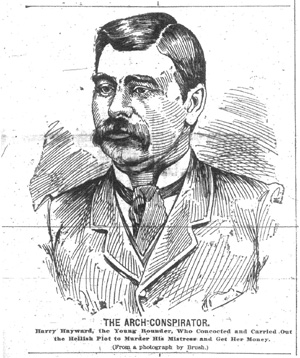 |
Minneapolis Pioneers and Soldiers Memorial Cemetery History Page Alley Article |
| Home | Burial Search | Friends | History | Photo Gallery | Visitor Information |
| Alley Articles |
|
This article originally appeared in the Phillips community's Alley Newspaper, October 2004.
Cold Case...Still Mysterious...Finally Solved! Despite the fact that it's been almost 110 years since he died, Harry Hayward remains the most talked about person buried in Minneapolis Pioneers and Soldiers Memorial Cemetery. Hayward was convicted of masterminding Minnesota 's crime of the 19th century, the murder for hire of Catherine “Kitty” Ging on December 3, 1894. Hayward, who had a reputation as a womanizer and a gambler, persuaded Miss Ging to sign over two life insurance policies, each worth $5,000, to him. By all accounts, she was infatuated with Hayward, and that infatuation led to her death. Hayward offered Claus Blixt, the alcoholic caretaker of the Ozark Flats apartment buildingn where Hayward and Ging both lived, $2,000 to drive Kitty Ging out by Lake Calhoun and shoot her. Blixt initially agreed but then tried to back out of the deal at which point Hayward threatened to harm Blixt's family. Minneapolis' newspapers of the day offered up a number of suspects and conspiracy theories in an effort to keep the public's interest in the murder from flagging. The police were not so gullible; they suspected Harry from the first, and although it took them three days, they finally “sweated” a confession out of Claus Blixt that implicated Hayward. Once Hayward was behind bars the press tried to link him to just about every unsolved murder that had been committed previously, not only in Minnesota but in locations as far away as New York. The trial lasted 46 days, and the jurors heard from 138 witnesses before finding Hayward guilty of first degree murder on March 8, 1895. His appealed his conviction but only managed to delay his execution. Hayward was hanged on December 11, 1895. After the hanging, rumors about Hayward persisted. There were stories that he had insisted that the gallows be painted red and that he be hanged in formal evening clothes. This led some to believe that Hayward had faked his own death by wearing an iron collar underneath his celluloid shirt collar. Friends supposedly helped Hayward escape to Chicago, a rumor that was fueled by the fact that Hayward's body was taken to Chicago to be cremated. The explanation was much simpler— Minneapolis did not have a crematorium “Murder in Minnesota,” a book written by Walter Trenerry in 1962, mistakenly claimed that Hayward was buried in Lakewood Cemetery thus creating one more controversy about Harry Hayward. But Minneapolis Pioneers and Soldiers Cemetery records clearly prove that, for better or worse, Harry Hayward's ashes are buried in Phillips.
Next Article -> Mary Prescott -- November 2004 |
|
©Friends of the Cemetery, 2005-2008 Contact us at history@friendsofthecemetery.org |
File last updated: Monday May 23, 2005 |
 Harry Hayward
Harry Hayward